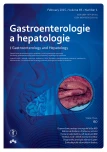Eradication of perianal fistulas in IBD patients using the Advancement Flap method and risk factors associated with poor healing
Authors:
Z. Šerclová 1; O. Ryska 1; J. Kalvach 2; J. Marvan 3
Authors‘ workplace:
Chirurgické oddělení, Nemocnice Hořovice, a. s.
1; Chirurgická klinika 2. LF UK a ÚVN Praha
2; Chirurgická klinika Nemocnice Na Bulovce, Praha
3
Published in:
Gastroent Hepatol 2015; 69(1): 25-28
Category:
IDB: Original Article
doi:
https://doi.org/10.14735/amgh201525
Overview
Complex perianal fistulas largely influence the life of IBD patients. Conservative treatment methods do not lead to complete healing. The success rate of surgical treatment by a closure of the inner opening by advancement flap (AF) varies between 24–100%. The aim of the study was to identify the risk factors of impaired healing of AF in IBD patients and to evaluate the long-term results of fistula eradication.
Methods:
IBD patients from a prospective database operated using the AF method in the period 2005–2013 were enrolled. Patients were pretreated with long-term perianal drainages. Continuing secretion from the external orifice occurring within three months following the AF was evaluated as healing failure. Fistulas that appeared after this period were evaluated as a relapse. Statistical analysis was performed using the MedCalc 11.4.4.0 software.
Results:
A total of 101 patients – 59 females (58%), age 35 ± 10 years, were followed for 17 (4–88) months. The interval between the first drainage to AF was 11 (1–58) months. Primary healing was achieved in 88 (87%) patients, the recurrence rate was 6%. Concomitant therapy did not influence the healing. Recto-vaginal localization was identified as a significant risk factor of impaired healing (RR 2.88; CI 95%: 1.1–7.8). The pretreatment period before a surgical intervention by the authors was significantly shorter in the group of patients with successfully healed flaps (0.5 (0–8) vs 3 (0–10) years; p = 0.001).
Conclusion:
The success rate of eradication of complex perianal fistulas in IBD patients by the AF method is high, with a low frequency of healing failure (13%) and low recurrence rate (6%). Recto-vaginal localization of fistulas was identified as a significant risk factor of healing failure. Early surgical treatment according to protocol significantly improves healing.
Key words:
complex perianal fistula – IBD – advancement flap – risk factors
The authors declare they have no potential conflicts of interest concerning drugs, products, or services used in the study.
The Editorial Board declares that the manuscript met the ICMJE „uniform requirements“ for biomedical papers.
Submitted:
30. 12. 2014
Accepted:
29. 1. 2015
Sources
1. Schwartz DA, Pemberton JH, Sandborn WJ. Diagnosis and treatment of perianal fistulas in Crohn disease. Ann Intern Med 2001; 135(10): 906– 918.
2. Mahadev S, Young JM, Selby W et al. Self‑ reported depressive symptoms and suicidal feelings in perianal Crohn‘s disease. Colorectal Dis 2012; 14(3): 331– 335. doi: 10.1111/ j.1463‑ 1318.2011.02613.x.
3. Ng SC, Plamondon S, Gupta A et al. Prospective assessment of the effect on quality of life of anti‑tumour necrosis factor therapy for perineal Crohn‘s fistulas. Aliment Pharmacol Ther 2009; 30(7): 757– 766. doi: 10.1111/ j.1365‑ 2036.2009.04088.x.
4. Yassin NA, Askari A, Warusavitarne J et al.Systematic review: the combined surgical and medical treatment of fistulising perianal Crohn‘s disease. Aliment Pharmacol Ther 2014; 40(7): 741– 749. doi: 10.1111/ apt.12906.
5. Sandborn WJ, Fazio VW, Feagan BG et al.AGA technical review on perianal Crohn’s disease. Gastroenterology 2003; 125(5): 1508– 1530.
6. Soltani A, Kaiser AM. Endorectal advancement flap for cryptoglandular or Crohn‘s fistula‑ in‑ano. Dis Colon Rectum 2010; 53(4): 486– 495. doi: 10.1007/ DCR.0b013e 3181ce 8b01.
7. Jarrar A, Church J. Advancement flap repair: a good option for complex anorectal fistulas. Dis Colon Rectum 2011; 54(12): 1537– 1541. doi: 10.1097/ DCR.0b013e31822d7ddd.
8. Joo JS, Weiss EG, Nogueras JJ et al. Endorectal advancement flap in perianal Crohn‘s disease. Am Surg 1998; 64(2): 147– 150.
9. Van der Hagen SJ, Baeten CG, Soeters PB et al. Staged mucosal advancement flap for the treatment of complex anal fistulas: pretreatment with noncutting Setons and in case of recurrent multiple abscesses a diverting stoma. Colorectal Dis 2005; 7(5): 513– 518.
10. Yamamoto T, Allan RN, Keighley MR. Risk factors for intra‑ abdominal sepsis after surgery in Crohn‘s disease. Dis Colon Rectum 2000; 43(8): 1141– 1145.
11. Sciaudone G, Di Stazio C, Limongelli Pet al. Treatment of complex perianal fistulas in Crohn disease: infliximab, surgery or combined approach. Can J Surg 2010; 53(5): 299– 304.
12. Lakatos PL, Czegledi Z, Szamosi T et al. Perianal disease, small bowel disease, smoking, prior steroid or early azathioprine/ biological therapy are predictors of disease behavior change in patients with Crohn‘s disease. World J Gastroenterol 2009; 15(28): 3504– 3510.
13. Mizrahi N, Wexner SD, Zmora O et al. Endorectal advancement flap: are there predictors of failure? Dis Colon Rectum 2002; 45(12): 1616– 1621.
14. Sonoda T, Hull T, Piedmonte MR et al. Outcomes of primary repair of anorectal and rectovaginal fistulas using the endorectal advancement flap. Dis Colon Rectum 2002; 45(12): 1622– 1628.
15. Valente MA, Hull TL. Contemporary surgical management of rectovaginal fistula in Crohn‘s disease. World J Gastrointest Pathophysiol 2014; 5(4): 487– 495. doi: 10.4291/ wjgp.v5.i4.487.
Labels
Paediatric gastroenterology Gastroenterology and hepatology SurgeryArticle was published in
Gastroenterology and Hepatology

2015 Issue 1
Most read in this issue
- A practical contribution to the diagnostics and treatment of focal nodular hyperplasia and adenomas in the liver from the perspective of a hepatologist, radiologist, pathologist and surgeon
- Small intestinal bacterial overgrowth syndrome
- Topical treatment of inflammatory bowel diseases
- Nutricia enteral nutrition products for children
